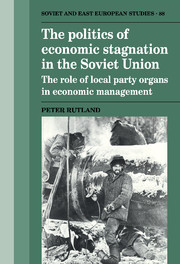 The Politics of Economic Stagnation in the Soviet Union
The Politics of Economic Stagnation in the Soviet Union Book contents
- Frontmatter
- Contents
- List of tables
- Preface
- Glossary of Russian terms and abbreviation
- Introduction: The party in the post-totalitarian system
- 1 The party and the economy: structures and principles
- 2 Party interventions in industry
- 3 Interventions in industry: case studies
- 4 The party as regional coordinator
- 5 Regional coordination: case studies
- 6 The party as fireman: party interventions in the transport and energy sectors
- 7 The role of the party in agriculture
- 8 Non-party control organs
- 9 The principles underlying the party's work with cadres
- 10 The obkom elite in the 1980s
- 11 Party and economy under perestroika
- Conclusion Party and economy in the USSR: from stagnation to collapse
- Appendices
- Notes
- Bibliography
- Index
- THE POLITICS OF ECONOMIC STAGNATION IN THE SOVIET UNION
Introduction: The party in the post-totalitarian system
Published online by Cambridge University Press: 06 July 2010
- Frontmatter
- Contents
- List of tables
- Preface
- Glossary of Russian terms and abbreviation
- Introduction: The party in the post-totalitarian system
- 1 The party and the economy: structures and principles
- 2 Party interventions in industry
- 3 Interventions in industry: case studies
- 4 The party as regional coordinator
- 5 Regional coordination: case studies
- 6 The party as fireman: party interventions in the transport and energy sectors
- 7 The role of the party in agriculture
- 8 Non-party control organs
- 9 The principles underlying the party's work with cadres
- 10 The obkom elite in the 1980s
- 11 Party and economy under perestroika
- Conclusion Party and economy in the USSR: from stagnation to collapse
- Appendices
- Notes
- Bibliography
- Index
- THE POLITICS OF ECONOMIC STAGNATION IN THE SOVIET UNION
Summary
Understanding Soviet politics
The most distinctive feature of the Soviet political system was the role of the Communist Party. While other nations around the world are grouped into democracies and dictatorships, the Soviet Union belonged to the class of Leninist party regimes in which power is concentrated in the hands of a political party, and not a military elite, a ruling family, an economic class or a religious sect.
Leninist regimes came about in one of two ways. Some were simply imposed by force from outside. This was the case for most of Eastern Europe and for parts of the USSR (the Baltic, Caucasus, etc.). The remainder were the results of indigenous social revolutions, again involving military force and external assistance. Socialist revolutions took place in predominantly peasant societies at the periphery of the world system, whose traditional political elites were unable to respond to the social transformations set in motion by the arrival of capitalism. Leninist parties proved themselves willing and able to seize power in those societies, and constructed political and economic systems which outlived their founders.
Western scholars agree that socialist regimes have been able to achieve short-run stability, based largely on repression. There is deep disagreement, however, over the long-run viability of these systems. Is a Leninist regime able to achieve broad popular legitimacy, and shift the basis of its rule from coercion to consent? Can a ruling communist party create an economic system capable of meeting the needs of its population?
- Type
- Chapter
- Information
- The Politics of Economic Stagnation in the Soviet UnionThe Role of Local Party Organs in Economic Management, pp. 1 - 23Publisher: Cambridge University PressPrint publication year: 1992


